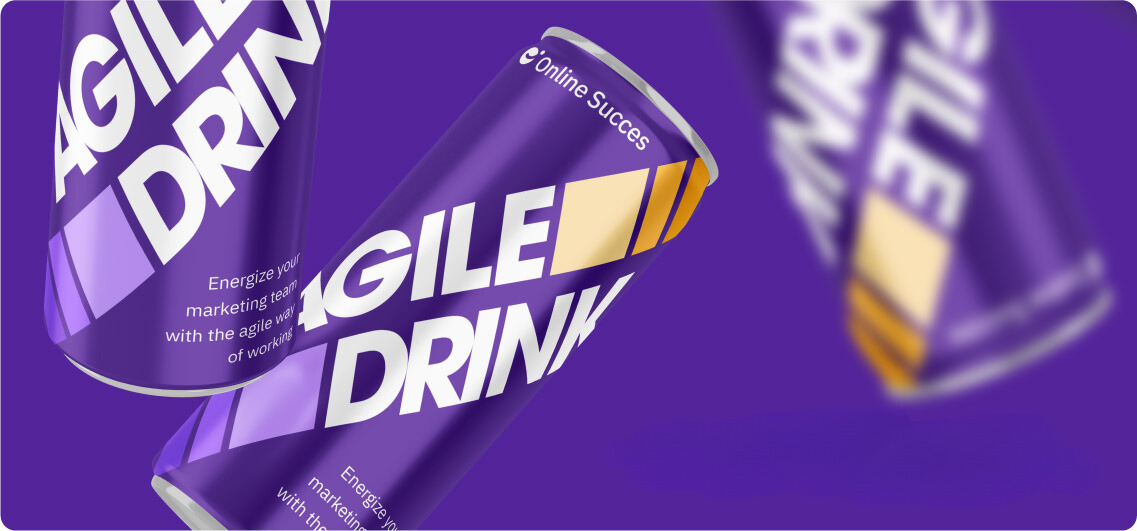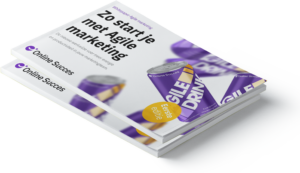In my experience, marketing professionals are passionate people. They love creativity. New ideas. Doing things intuitively. Thinking big.
At the same time, marketing teams are legendary in working overtime. Walk into any agency and feel the impact of deadlines: tense faces, chaos and busy office managers. All this does not contribute to the satisfaction and happiness of marketing teams. Why does the marketing sector struggles with this?
A solution to stress and change
Research by Forrester and Agile Sherpas looked at how marketing teams work. They ultimately define three ways marketing departments are managed.
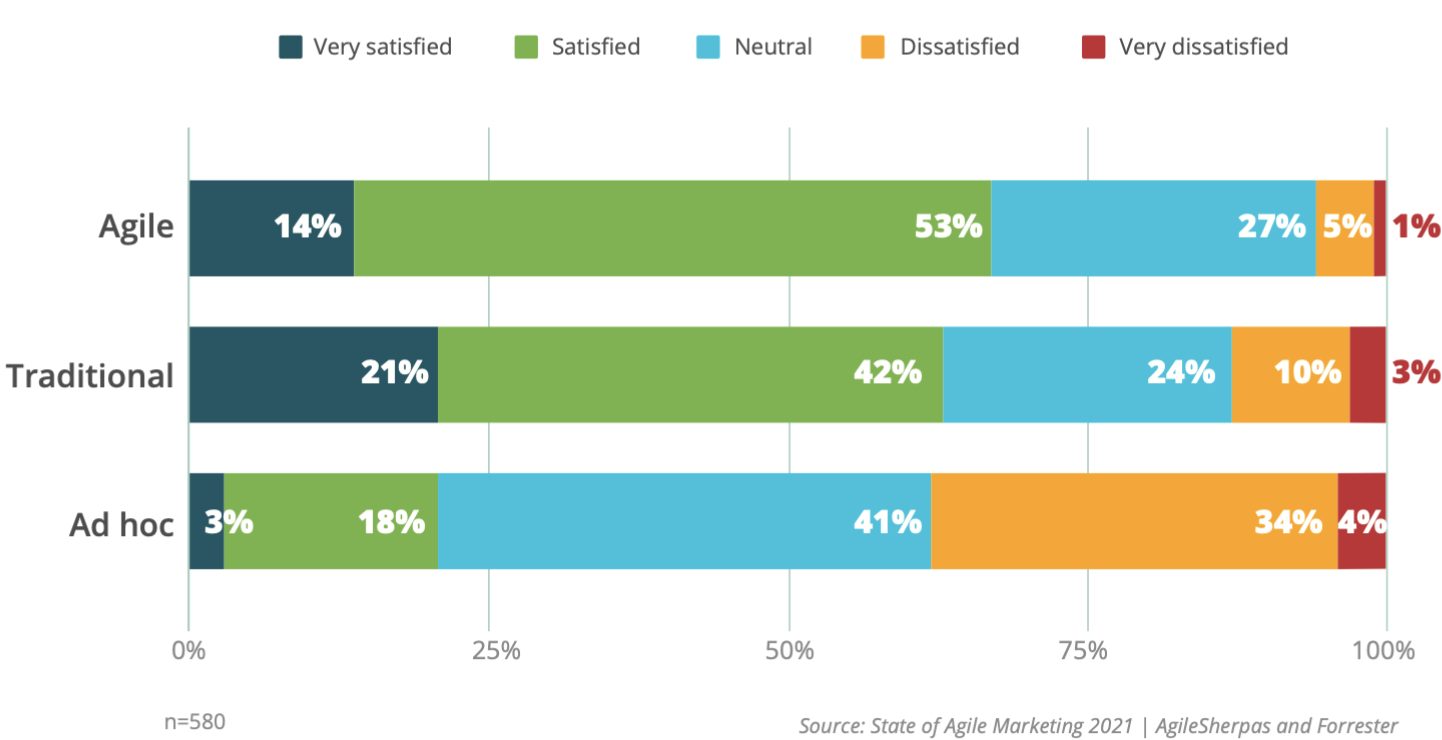
There are traditional departments, Agile marketing departments and ad-hoc departments. It turns out that marketers in traditional departments are twice as likely to be dissatisfied as those in Agile departments. And ad-hoc teams – those working without a proper planning – are more than six times(!) as likely to be dissatisfied as teams working with Agile principles.
What is Agile marketing
Agile marketing helps marketing and communication professionals spend less time writing thick plans. Moreover, Agile professionals make better use of data and can apply insights faster. According to the report by AgileSherpas ‘The Annual State of Agile Marketing‘ 51 percent of marketers used Agile methods in 2021. But what exactly is it?
Definition of Agile marketing
Agile marketing is a way to organize marketing work using Agile principles and lightweight frameworks such as Scrum. Think of self-organizing, cross-functional teams that are continuously improving their approach based on feedback and data.
In 2012, a group of marketers came together who have developed standards based on well-known Agile practices from the software world. This manifesto is the basis for many marketing departments to improve their ways of working. The document centers on four concepts: Agile-based teamwork, data-driven decisions, rapid and iterative releases and adherence to the Agile Marketing Manifesto.
Agile tools in Marketing
Agile is more than just a vision. This way of working offers a complete toolbox to make your team run smoothly.
A few tools highlighted:
- The Sprint Planning – Teams set up a plan every 2 weeks.
- The Daily Scrum – an event for catching up in just 15 minutes each morning.
- The Sprint Review – Here, the team shows progress made during the past 2 weeks.
- The board – A tool to make work visible.
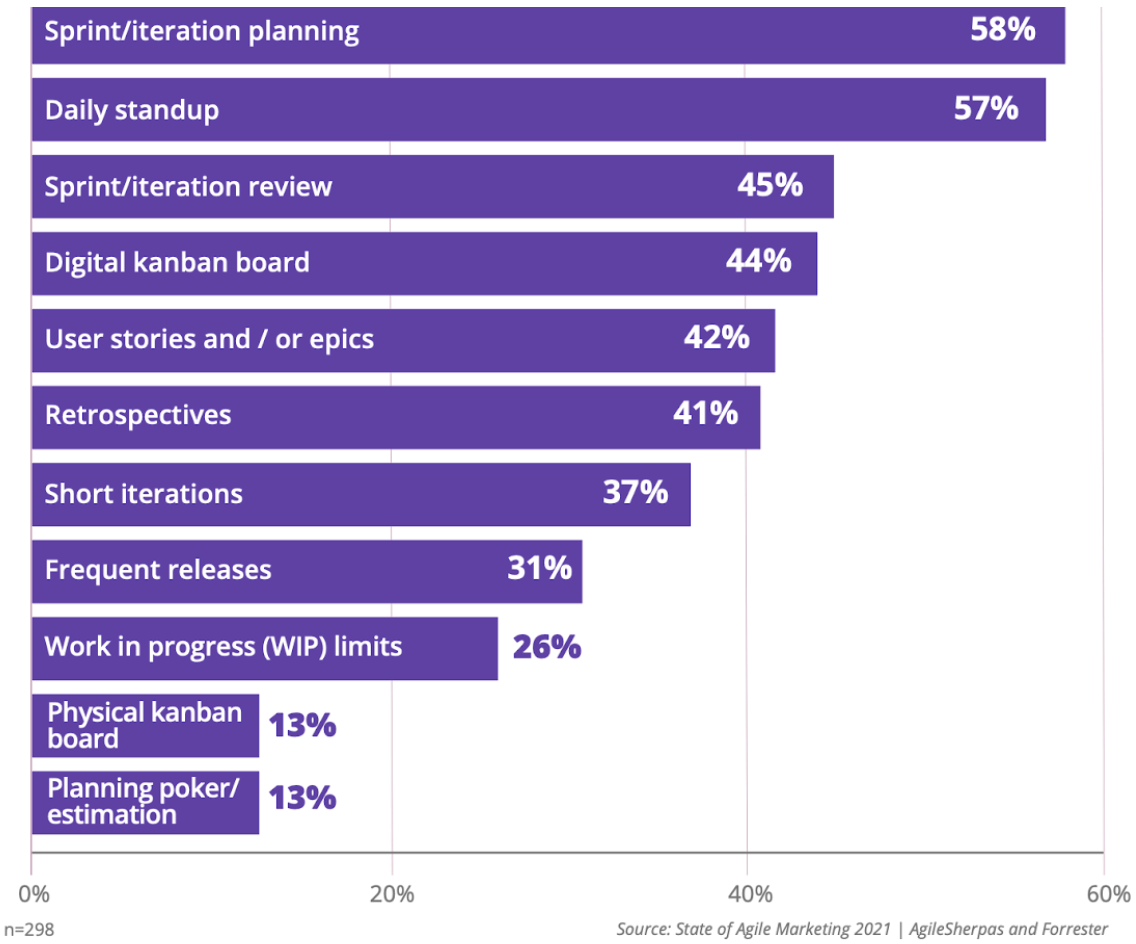
In the following blogs, we will dig deeper into the various tools and events.
Differences Between Agile, Lean and Scrum
The terms may sound familiar: Agile, Lean and Scrum. But what are the differences? And how are they applied? I have lined up the definitions for you.
Lean is a management style or a business philosophy focused on creating value for the customer. Here, reducing waste is an important element. The best-known example is the Toyota production system, which continuously looks at new customer needs and optimizes the production system. The system has been so successful that Toyota has remained profitable during recessions, unlike many companies in the automotive industry.
Agile literally means being flexible. Lean and Agile have many similarities. The biggest difference is that Lean is often used when talking about improving a production process. Agile is more often seen in departments where complex work is executed, such as in software or marketing teams.
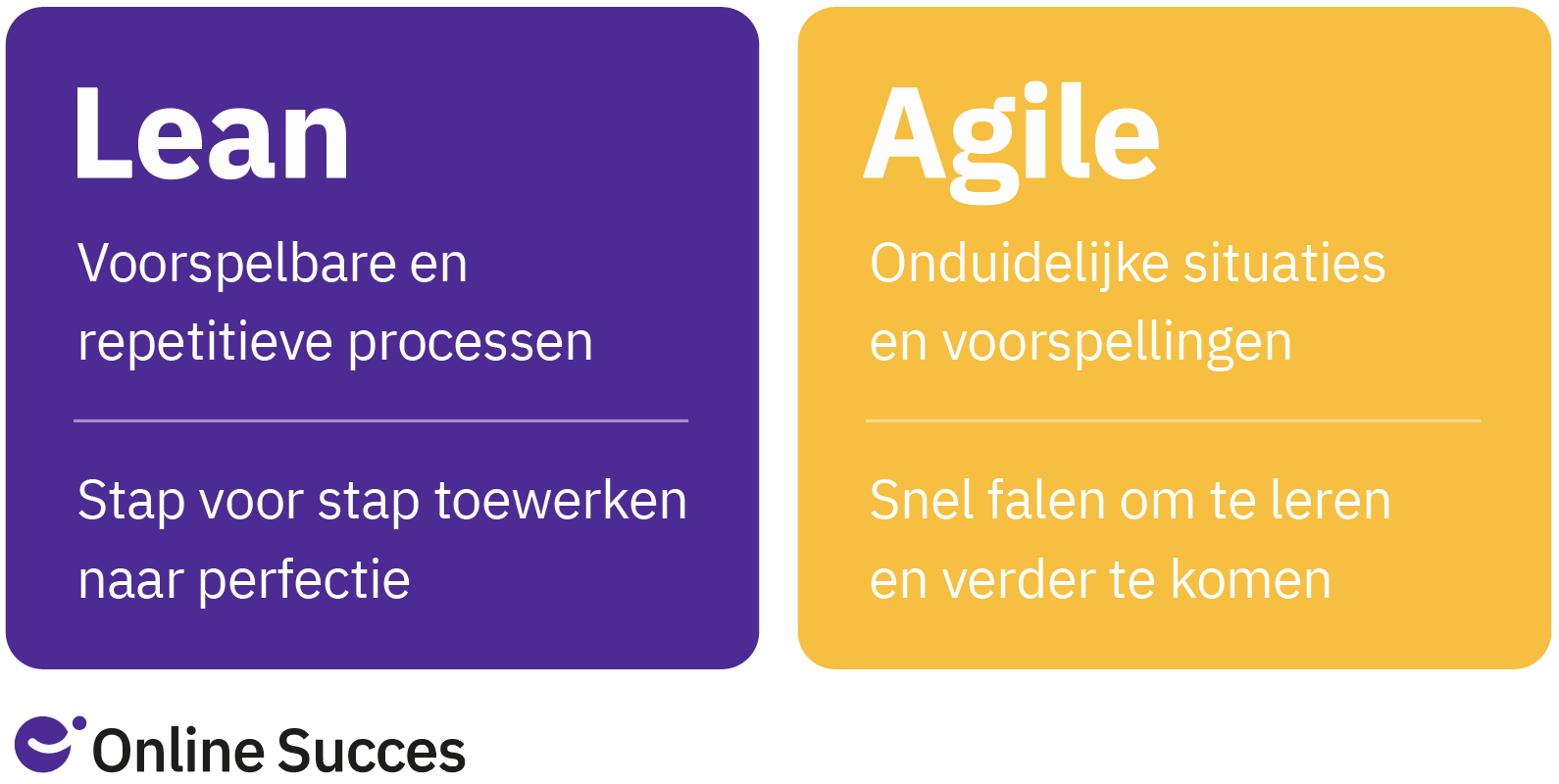
Scrum is a concrete framework that your marketing department can use to work in an Agile way. Where Lean and Agile talk about vision and principles, Scrum provides the practical tools to get started and keep you going. This includes working in sprints of 2 to 4 weeks, with predefined roles within the team. There are more systems like Scrum, including Kanban and the less known DSDM (Dynamic System Development Method).
In practice, you see that most organizations first expiriment with Agile frameworks. Where one team may swear by Scrum and bi-weekly Sprints, that might not work as well for another team, which then tries out Kanban, for example. See an Agile way of working as a way to deploy proven practices and principles that help your team work more effectively and efficiently.
Why marketing teams increasingly choose to work Agile
More and more marketing teams work Agile. The previously mentioned report ‘The Annual State of Agile Marketing’ notes a 10% growth in organizations actively using one or more Agile ways of working. In 2021, B2B marketing teams led the way with just over half (52%) of the teams saying they work Agile. It’s defiately different in B2C, where only 12% says they work in an Agile way.
Why B2B marketing teams choose Agile? Key reasons are: Key reasons are:
- Being flexible in times of change
- Better alignment with business objectives
- Desire for better insight into project priorities and progress
- More effective use of resources
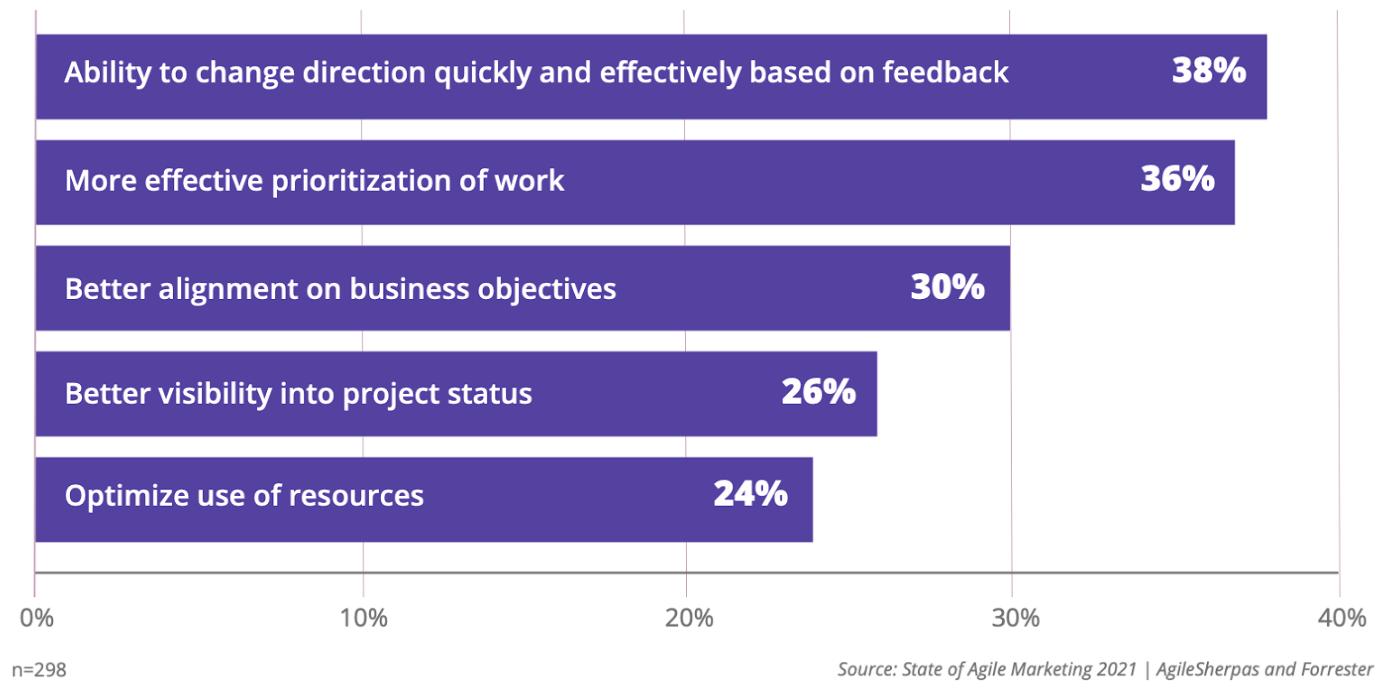
Agile got a boost from remote working (and the need for project management software)
In 2020, remote working exploded with a growing need for project management software as a result (55% in 2020, up from 39% in 2019). And although using software doesn’t necessarily mean you are working Agile, you do see many tools that support this flexible way of working. Good examples include Jira Software and Jira Work Management from Atlassian.
The 6 benefits of working Agile
If you are still working with annual plans, then switching to Agile is a big step It’s not a decision you make lightly. Below are 6 benefits that can convince you.
1. Happy and energetic marketing teams
Perhaps the most important: Agile marketing teams are the most satisfied with their work compared to teams that have not embraced this way of working. These are the figures from the research ‘4th annual state of Agile marketing’:
- 67% of Agile marketers are satisfied with their work.
- Traditional marketers are almost as satisfied: 63% of them say their way of working is satisfying.
- Among marketers who work without planning, only 21% are satisfied with their work.
2. Speed and productivity
And in the mentioned research, more benefits are articulated. Agile marketers are much more positive about their ability to respond to changes in trends such as digitalization. Moreover, these marketers indicate better alignment with the overall business strategy. How is this possible? The main reason mentioned is that Agile teams are not grouped by function, but work based on small, cross-functional teams.
3. Better collaboration and alignment with the rest of the organization
What challenge do B2B marketers face year after year? Right, collaboration with sales is a point of attention in every trend report. Sales always wants to move faster than marketing can produce resources and apparently it just doesn’t work to break this pattern. Agile marketers are more satisfied with the collaboration with the rest of the organization. So if your marketing team wants better integration? Then get started with Agile marketing.
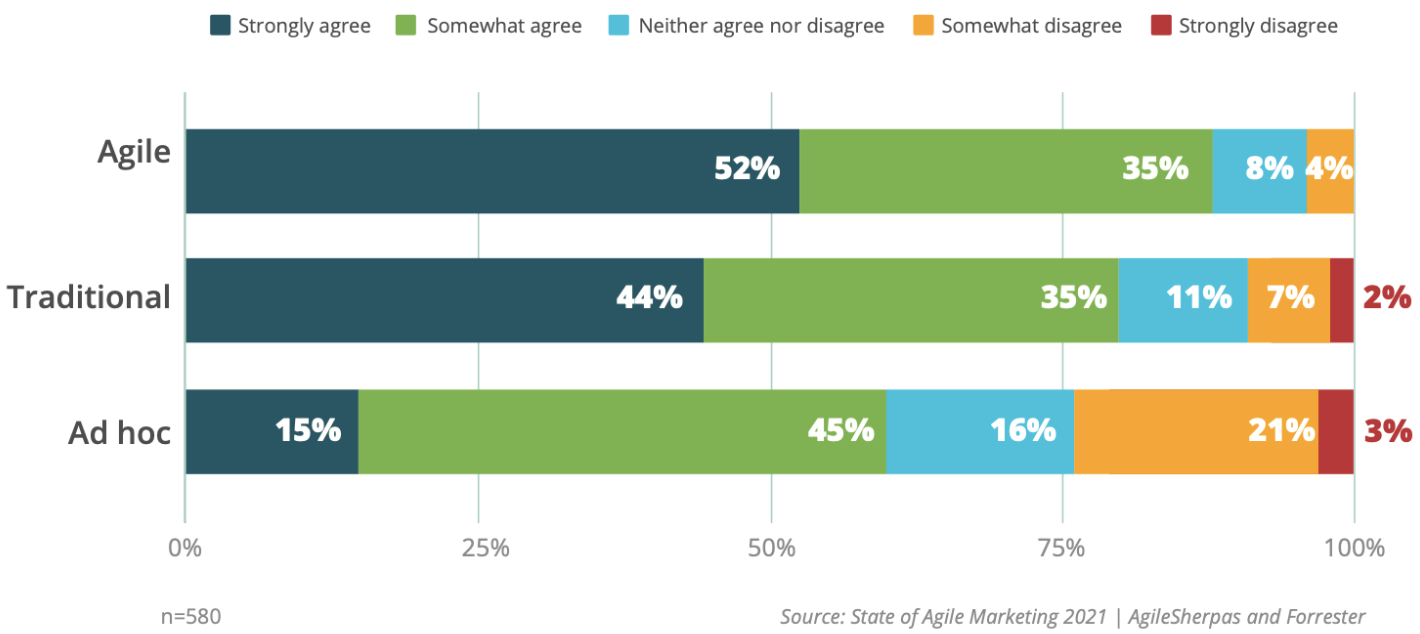
4. Transparency and collaboration
Visualized workflows and fixed meeting times; another advantage of Agile marketing is that the work is always visible and open for discussion. An example? Take the physical Scrum- or Kanban-board: a large board in your department where tasks are visible to everyone. This stimulates communication, creates accountability and promotes productivity.
5. Flexibility
How often have you revised your annual marketing plan? No team can know exactly what the next 12 months will bring. With Agile, you have an answer to change. With a plan for the next 2-4 weeks, you can quickly switch gears when priorities change. Agile teams have long-term goals but look at each sprint to see what the next, most effective step is to get there.
6. Data-driven
One of the pillars of the Agile Marketing Manifesto is data. This focus helps teams to remain critical of the effectiveness of created campaigns, deployed channels and the contribution to sales. Here, input from customers is essential. This, combined with the ability to act quickly, makes your marketing team Agile in the best way.
7. Increased competitiveness
When your Agile engine is running at full throttle, you’ll notice that you respond faster to market changes than your competitors. You see opportunities and are able to quickly launch campaigns for new segments, propositions and channels. And with a focus on data, you are able to deploy your budgets more effectively than other players in the market.
Your next step
Today you’ve had a brief introduction to Agile marketing. You’ve read about the principles and added value of this new way of working for marketing teams. Do you feel that Agile marketing is something for your organization? And want to take the next step? Then identify challenges in your department where an Agile approach can help. This will help you determine if your interest in Agile working stems from enthusiasm or if it is a way of working that will truly make an impact for your team.
Over to you
I’m curious, how does your marketing team organize its work? Traditional, ad hoc or perhaps Agile? And what are your experiences? Share your insights or thoughts in the comments below!
